Answered step by step
Verified Expert Solution
Question
1 Approved Answer
you can put whatever you want for the heapinput.txt. ex: 1 5 6 7 9 0 12 3 4 15 In your second programming project,

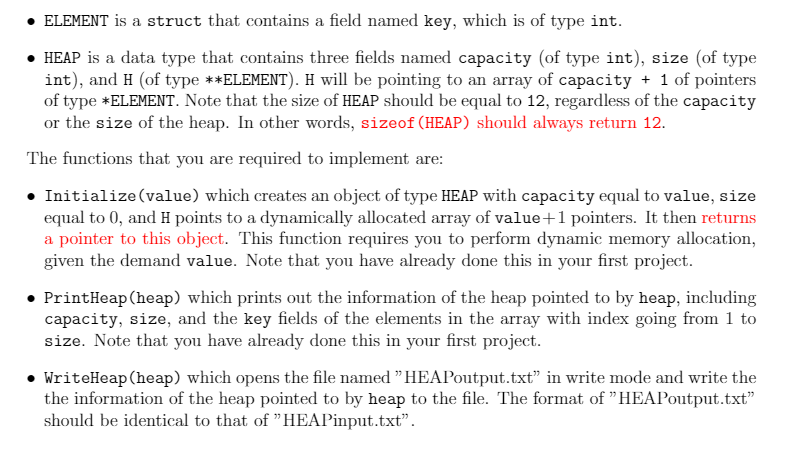

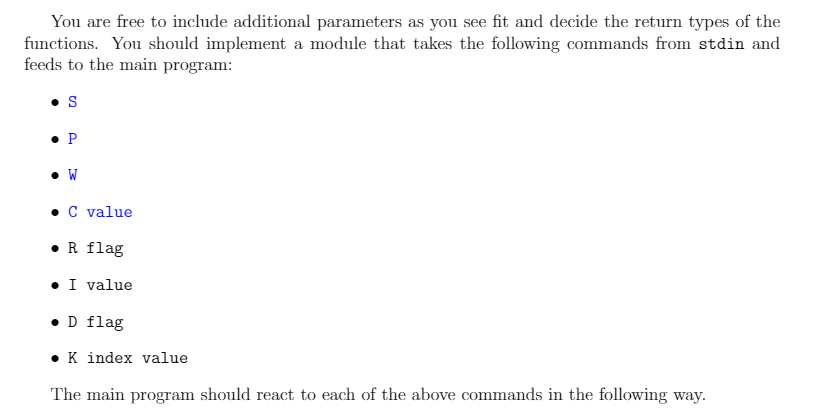
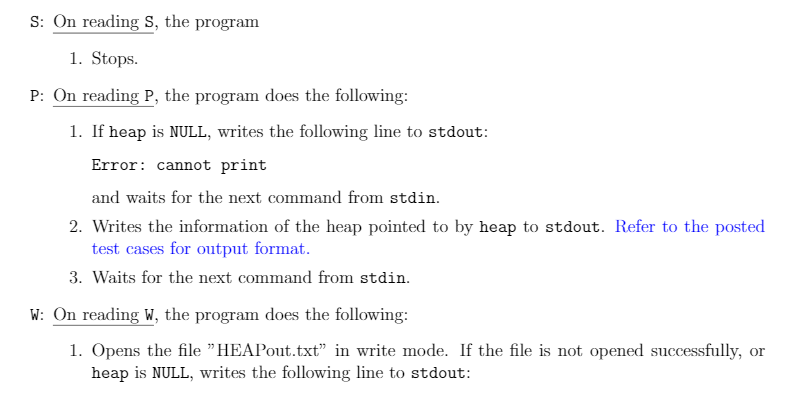
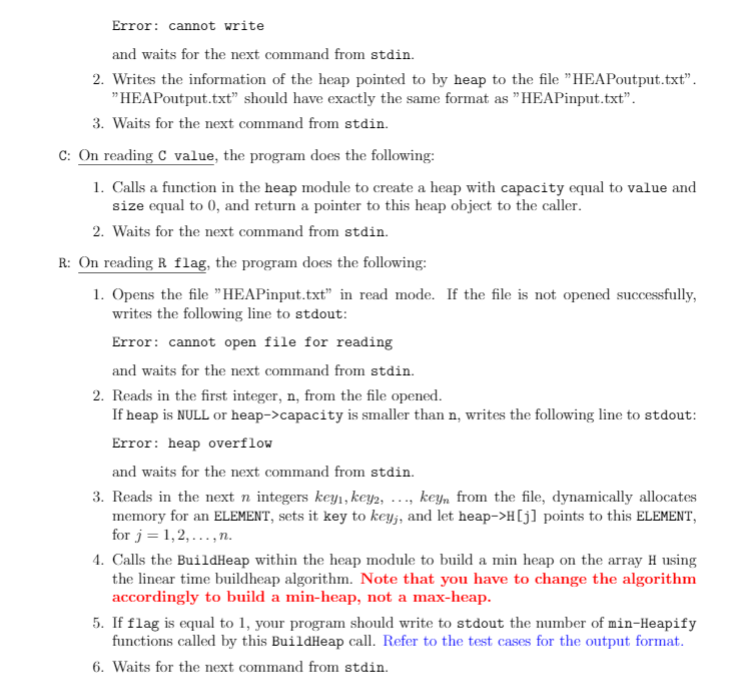

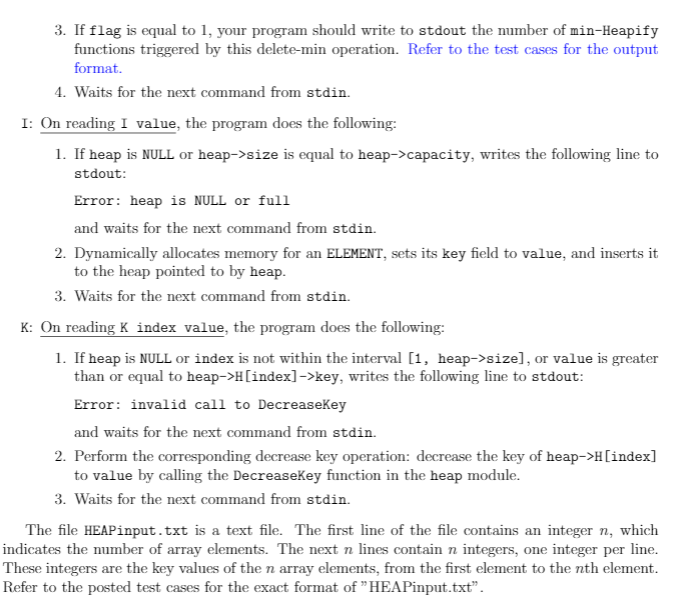
you can put whatever you want for the heapinput.txt.
ex:
1
5
6
7
9
0
12
3
4
15
In your second programming project, you will expand your first project. As in the case of the first programming project, it should be implemented in C++, on a Linux platform such as general.asu.edu. Your program will be graded on Gradescope, which uses a Linux platform. You will continue to have modular design, provide a Makefile to compile various modules to generate the executable file named run. Among other things, you need to have 1. a main program, which coordinates all other modules; 2. a module that provides utility services including command line interpretation; 3. a module that implements the min-heap data structure (all heap functions); 4. a Makefile which compiles all modules and link them into the executable. ELEMENT is a struct that contains a field named key, which is of type int. HEAP is a data type that contains three fields named capacity (of type int), size (of type int), and H of type **ELEMENT). H will be pointing to an array of capacity + 1 of pointers of type *ELEMENT. Note that the size of HEAP should be equal to 12, regardless of the capacity or the size of the heap. In other words, sizeof (HEAP) should always return 12. The functions that you are required to implement are: Initialize(value) which creates an object of type HEAP with capacity equal to value, size equal to 0, and H points to a dynamically allocated array of value+1 pointers. It then returns a pointer to this object. This function requires you to perform dynamic memory allocation, given the demand value. Note that you have already done this in your first project. PrintHeap (heap) which prints out the information of the heap pointed to by heap, including capacity, size, and the key fields of the elements in the array with index going from 1 to size. Note that you have already done this in your first project. WriteHeap (heap) which opens the file named "HEAPoutput.txt in write mode and write the the information of the heap pointed to by heap to the file. The format of "HEAPoutput.txt" should be identical to that of "HEAPinput.txt. Insert (heap, element) which inserts an object of type ELEMENT pointed to by element into the heap pointed to by heap. ExtractMin(heap) which deletes the minimum element from the heap pointed to by heap. DecreaseKey (heap, index, value) which decreases the key of heap->H[index] to value. min-Heapify(heap, index) which performs the heapify function at index of the array pointed to by heap->H. You are free to include additional parameters as you see fit and decide the return types of the functions. You should implement a module that takes the following commands from stdin and feeds to the main program: S P P W C value R flag . I value D flag K index value The main program should react to each of the above commands in the following way. S: On reading S, the program 1. Stops. P: On reading P, the program does the following: 1. If heap is NULL, writes the following line to stdout: Error: cannot print and waits for the next command from stdin. 2. Writes the information of the heap pointed to by heap to stdout. Refer to the posted test cases for output format. 3. Waits for the next command from stdin. W: On reading W, the program does the following: 1. Opens the file "HEAPout.txt" in write mode. If the file is not opened successfully, or heap is NULL, writes the following line to stdout: Error: cannot write and waits for the next command from stdin. 2. Writes the information of the heap pointed to by heap to the file "HEAPoutput.txt. "HEAPoutput.txt" should have exactly the same format as HEAPinput.txt. 3. Waits for the next command from stdin. C: On reading C value, the program does the following: 1. Calls a function in the heap module to create a heap with capacity equal to value and size equal to 0), and return a pointer to this heap object to the caller. 2. Waits for the next command from stdin. R: On reading R flag, the program does the following: 1. Opens the file "HEAPinput.txt" in read mode. If the file is not opened successfully, writes the following line to stdout: Error: cannot open file for reading and waits for the next command from stdin. 2. Reads in the first integer, n, from the file opened. If heap is NULL or heap->capacity is smaller than n, writes the following line to stdout: Error: heap overflow and waits for the next command from stdin. 3. Reads in the next n integers key, key2, ..., keyn from the file, dynamically allocates memory for an ELEMENT, sets it key to key, and let heap->H[j] points to this ELEMENT, for j =1,2,...,n. 4. Calls the BuildHeap within the heap module to build a min heap on the array H using the linear time buildheap algorithm. Note that you have to change the algorithm accordingly to build a min-heap, not a max-heap. 5. If flag is equal to 1, your program should write to stdout the number of min-Heapify functions called by this BuildHeap call. Refer to the test cases for the output format. 6. Waits for the next command from stdin. D: On reading D flag, the program does the following: 1. If heap is NULL or heap->size is 0, writes the following line to stdout: Error: heap is NULL or empty and waits for the next command from stdin. 2. Deletes the minimum element from the heap and writes to stdout the key of the deleted element. Refer to the test cases for output format. 3. If flag is equal to 1, your program should write to stdout the number of min-Heapify functions triggered by this delete-min operation. Refer to the test cases for the output format. 4. Waits for the next command from stdin. I: On reading I value, the program does the following: 1. If heap is NULL or heap->size is equal to heap->capacity, writes the following line to stdout: Error: heap is NULL or full and waits for the next command from stdin. 2. Dynamically allocates memory for an ELEMENT, sets its key field to value, and inserts it to the heap pointed to by heap. 3. Waits for the next command from stdin. K: On reading K index value, the program does the following: 1. If heap is NULL or index is not within the interval [1, heap->size], or value is greater than or equal to heap->H[index]->key, writes the following line to stdout: Error: invalid call to Decreasekey and waits for the next command from stdin. 2. Perform the corresponding decrease key operation: decrease the key of heap->H[index] to value by calling the DecreaseKey function in the heap module. 3. Waits for the next command from stdin. The file HEAP input.txt is a text file. The first line of the file contains an integer n, which indicates the number of array elements. The next n lines contain n integers, one integer per line. These integers are the key values of the n array elements, from the first element to the nth element. Refer to the posted test cases for the exact format of "HEAPinput.txt
Step by Step Solution
There are 3 Steps involved in it
Step: 1

Get Instant Access to Expert-Tailored Solutions
See step-by-step solutions with expert insights and AI powered tools for academic success
Step: 2

Step: 3

Ace Your Homework with AI
Get the answers you need in no time with our AI-driven, step-by-step assistance
Get Started


